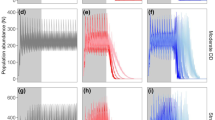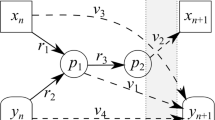Summary
Multi-annual population cycles can be generated by life history responses to density dependent changes in adult and pre-reproductive survival. The proximate mechanism linking population dynamics and demography of cycling rodents appears to be high pre-reproductive dispersal at peak density, or during periods of population increase. This model is similar to the Chitty hypothesis which can best be viewed as a special case of demographic control on population size. Normally, this control should be selfreinforcing and lead to damped oscillations toward a stable population density. Intrinsic time lags induced by variation in the length of the breeding season modify the dependence of demography on population size, and enable the cycles to persist.
Similar content being viewed by others
References
Beacham TD (1979) Size and growth characteristics of dispersing voles, Microtus townsendii. Oecologia (Berl) 42:1–10
Beacham TD (1980) Dispersal during population fluctuations of the vole, Microtus townsendii. J Anim Ecol 49:867–877
Beacham TD (1981) Some demographic aspects of dispersers in fluctuating populations of the vole Microtus townsendii. Oikos 36:273–280
Charnov EL, Finerty JP (1980) Vole population cycles: a case for kin-selection? Oecologia (Berl) 45:1–2
Chitty D (1958) Self-regulation of numbers through changes in viability. Cold Spring Harbor Symp Quant Biol 22:277–280
Chitty D (1960) Population processes in the vole and their relevance to general theory. Can J Zool 38:99–113
Chitty D (1967) The natural selection of self-regulatory behaviour in animal populations. Proc Ecol Soc Aust 2:51–78
Christian JJ (1950) The adreno-pituitary system and population cycles in mammals. J Mammal 31:247–259
Freeland WJ (1974) Vole cycles: another hypothesis. Am Nat 108:238–245
Gaines MS, McClenaghan LR Jr (1980) Dispersal in small mammals. Ann Rev Ecol Syst 11:163–196
Gaines MS, Rose RK (1976) Population dynamics of Microtus ochrogaster in eastern Kansas. Ecology 57:1145–1161
Gaines MS, Schaffer WM, Rose RK (1979a) Additional comments on reproductive strategies and population fluctuations in microtine rodents. Ecology 60:1284–1286
Gaines MS, Vivas AM, Baker CL (1979b) An experimental analysis of dispersal in fluctuating vole populations: demographic parameters. Ecology 60:814–828
Gaines MS, Baker CL, Vivas AM (1979c) Demographic attributes of dispersing southern bog lemmings (Synaptomys cooperi) in eastern Kansas. Oecologia (Berl) 40:91–101
Horn HS (1978) Optimal tactics of reproduction and life history. In: JR. Krebs, NB Davies (eds) Behavioural ecology. Sunderland, Massachusetts, Sinauer Associates pp 411–429
Krebs CJ (1978) A review of the Chitty hypothesis of population regulation. Can J Zool 56:2463–2480
Krebs CJ, Myers JH (1974) Population cycles in small mammals. Adv Ecol Res 8:267–399
Krebs CJ, Keller BL, Tamarin RH (1969) Microtus population biology: demographic changes in fluctuating populations of M. ochrogaster and M. pennsylvanicus in southern Indiana. Ecology 50:587–607
Krebs CJ, Gaines MS, Keller BL, Myers JH, Tamarin RH (1973) Population cycles in small rodents. Science 179:35–41
Lidicker WZ Jr (1975) The role of dispersal in the demography of small mammals. In: FB Golley, K Petrusewicz and L Ryszkowski (eds) Small mammals: their productivity and population dynamics. Cambridge, England, Cambridge University Press, pp 103–128
May RM (1981) Models for single populations. In: RM May (ed) Theoretical ecology, 2nd edition. Sunderland, Massachusetts, Sinauer Associates pp 5–29
Morris DW (1982) Age-specific dispersal strategies in iteroparous species: who leaves when? Evol Theory 6:53–65
Myers JH, Krebs CJ (1971) Genetic, behavioral, and reproductive attributes of dispersing field voles Microtus pennsylvanicus and Microtus ochrogaster. Ecol Monogr 44:53–78
Pitelka FA (1964) The nutrient-recovery hypothesis for arctic microtine cycles. I. Introduction. In: DJ Crisp (ed) Grazing in terrestrial and marine environments. Brit Ecol Soc Symp pp 55–56
Rosenzweig ML, Abramsky Z (1980) Microtine cycles: the role of habitat heterogeneity. Oikos 34:141–146
Schaffer WM (1974) Selection for optimal life histories: the effects of age-structure. Ecology 55:291–303
Schaffer WM, Tamarin RH (1973) Changing reproductive rates and population cycles in lemmings and voles. Evolution 27:111–124
Sokal RR, Rohlf FJ (1981) Biometry 2nd edition. San Francisco, WH Freeman and Company
Stearns SC (1976) Life-history tactics: a review of the ideas. Q Rev Biol 51:3–47
Stenseth NC (1978) Demographic strategies in fluctuating populations of small rodents. Oecologia (Berl) 33:149–172
Stenseth NC (1981) On Chitty's theory for fluctuating populations: the importance of genetic polymorphism in the generation of regular cycles. Theor Biol 90:9–36
Tamarin RH (1977) Demography of the beach vole (Microtus breweri) and the meadow vole (Microtus pennsylvanicus) in southeastern Massachusetts. Ecology 58:1310–1321
Tamarin RH (1978) Dispersal, population regulation, and K-selection in field mice. Am Nat 112:545–555
Author information
Authors and Affiliations
Rights and permissions
About this article
Cite this article
Morris, D.W. Rodent population cycles: life history adjustments to age-specific dispersal strategies and intrinsic time lags. Oecologia 64, 8–13 (1984). https://doi.org/10.1007/BF00377536
Received:
Issue Date:
DOI: https://doi.org/10.1007/BF00377536




